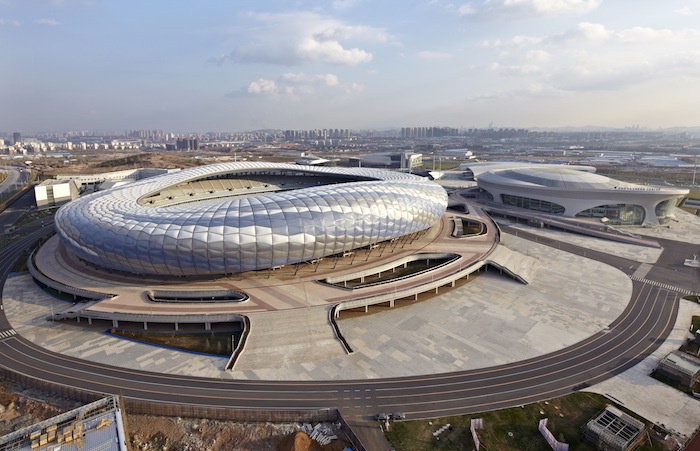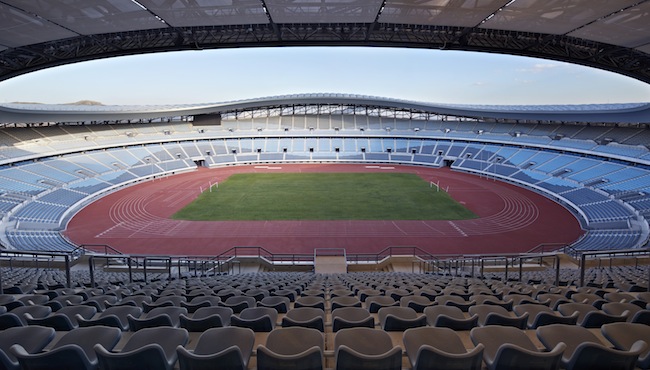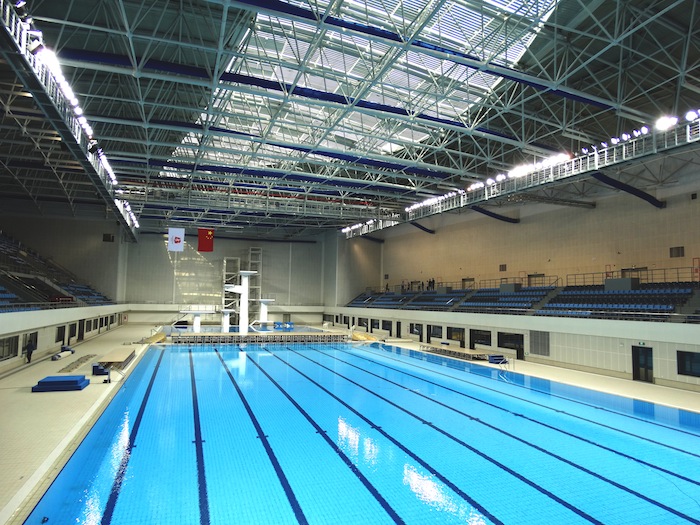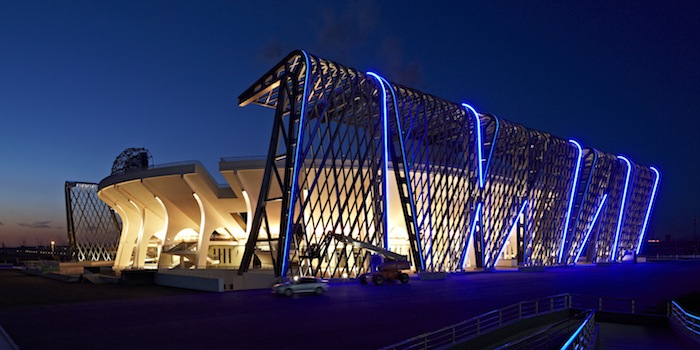Nadel Architects designed the new, world-class Dalian Sports Center, a massive 203-acre sports and entertainment complex located at 699 Lan Ling Rd., Ganjingzi District, Dalian, China on the Liaodong Peninsula adjacent to Korea.
The $1.5 billion project is the initial seed of urban development in the area. In addition to five major sports venues, the complex includes a 30-story, 440-room, 5-star Kempinski full-service hotel and conference center and a 40,500-square-meter athletes’ training facility and office building for coaches.
The sports complex, which hosted the China National Games upon completion of construction in September 2013, is designed to meet Olympic standards. The center is one of the only sports facilities in the world where all venues of this scale are incorporated on one site.
Venues include a 61,000-seat soccer stadium, an 18,000-seat indoor arena managed by AEG, a 9,600-seat tennis stadium, a 5,000-seat natatorium, a 3,000-seat baseball stadium, a comprehensive training and sports research facility as well as living quarters to accommodate athletes.

All photos: courtesy Nadel Architects
The city of Dalian prides itself as a “city of sports” with a specific reputation for being the “home of track and field,” “home of swimmers,” and the “city of soccer” in China.
Designed to accommodate numerous music concerts, sporting events, cultural and family events year-round, the new facility will not only serve as a regional sports center–propelling Dalian's world famous athletes to the forefront of training and international competition–but will also serve as an international tourist destination, entertainment venue and spiritually meaningful place to exercise, meditate and enjoy nature.
“In my 50-year career, this is the most remarkable project in which I’ve ever been involved,” said Herb Nadel, FAIA, founding principal of Nadel Architects. “I am terribly proud and excited to witness our team’s innovative design become a reality. Seeing this incredible center completed and built to world-class design standards is a true honor.”
Reinforcing the cohesiveness of the city's masterplan, the team, directed by Michael Hwa, planned the new year-round sports complex to connect residential neighborhoods with entertainment, retail and office space. The Dalian Sports Center creates a link through the heart of the city's newest development zone, becoming an anchor for the community and catapulting the city into a modern and connected city of the future.
Conceived as a “sports artery,” Dalian Sports Center incorporates an “S” shaped pathway as the main link between facilities during competition events. The pathway acts as a gently curving spine, crossing the site and connecting all the major venues like tendons connecting the muscles of the athletes.
Creatively blending landscape and the human form, the design effectively connects each of the sporting venues not only to each other, but also to the city's transportation infrastructure and to the community as a whole.
“The genesis behind the dynamic design of the facility was to capture the awe-inspiring speed, graceful lines and kinetic movements of competing athletes,” said Nadel. “Our design has connected the movement of the buildings with the muscles of the athletes – long graceful curves and lines – all providing a visual flow that captivates each person as they move through the complex.”
The main entrance to the sports center is a large, welcoming urban plaza that can accommodate up to 150,000 people. The cleverly landscaped plaza provides an immersive experience to the visitor through a necklace of intimately scaled spaces for relaxing, reading, meditation, tai chi, walking and enjoying music among seasonally changing gardens.
To conserve and reclaim water, these gardens have been ecologically engineered and terraced like traditional rice fields, flourishing year round with a variety of native plants and flowers.
The largest structure within the complex is the elliptical-shaped, 61,000-seat outdoor stadium, designed to accommodate soccer matches and other international sports competitions. Ethylene Tetrafluoroethylene (ETFE)–a transparent polymer popularized by Beijing’s Water Cube in the 2008 Summer Olympics–was used for the “skin” of the outdoor stadium due to its versatility.
The sophisticated material is lighter weight, transmits more light, insulates better and has a lower installation cost than glass or plastic. The stadium’s ETFE cushions, which are shades of white, grey and blue during the day, are illuminated with LED lights at night, displaying custom color patterns to represent the competing teams or to symbolize a particular event.
During winter, Dalian faces challenging weather and snow, requiring great ingenuity on the part of Nadel’s project team in the stadium’s design and materials used. To tackle this challenge, Nadel used Building Information Modeling (BIM) software to innovatively design, research and test the stadium exterior’s steel frame with a custom drainage system covered with a membrane of 2,745 ETFE cushions.
Adjacent to the outdoor stadium along the “S” pathway is the 18,000 seat indoor arena whose exterior features supple arching lines, representing an athlete’s muscles wrapping around a strong core. Managed by AEG, the indoor arena is used for an array of entertainment and sporting events including basketball, volleyball, table tennis, badminton, fencing, gymnastics, weight lifting, wrestling and martial arts, as well as a variety of music concerts.
The design of the natatorium was inspired by the waves of the sea. The natatorium boasts 5,000 spectator seats; a 10-lane, 50 meter pool for swimming, synchronized swimming and water polo competitions; a diving pool with 0.6, 2.6, 5.0, 7.5 and 10 meter diving platforms; an 8-lane, 50 meter warm up pool; and men’s and women’s locker rooms.
The 9,600-seat tennis stadium was designed to be both large and intimate, with every seat close to the action providing an unobstructed view of each event. The "seating bowl" of the arena sits within a live landscaped trellis structure, which embraces the spectators in field of green and light mirroring traditional European tennis venues and complementing the year-round landscaping of the “S” shaped pathway.
Nadel’s design team worked on a fast track schedule to complete the sports center in time for the 2013 China National Games. Nadel’s unique approach to the design and construction process allowed the entire project team to work together and develop an efficient timetable. The result is a facility that was completed under a tight deadline, without sacrificing the integrity of the design.
“This new facility is truly the architectural heart of the district, setting a benchmark for future developments that will serve the community,” said Nadel.
Joining Nadel on the project was Andrew Wolff, AIA, LEED® AP, senior designer; John Yang, project manager; and Michael Hwa, project director as well as a large team of designers and production staff.
Project Specifications
The 203-acre sports and entertainment complex features several areas for events and activities, including:
- 61,000-seat soccer stadium
- 18,000-seat indoor arena
- 9,600-seat tennis stadium
- 5,000-seat natatorium
- 3,000-seat baseball stadium
- 30-story, 440 room, 5-star Kempinski Hotel and media center
- 40,500-square-meter training and support research facility with 4 levels of athletic training space and 6 levels of office space for coaches
About Nadel Architects
For the past 40 years, Nadel Architects has provided comprehensive services ranging from architectural design, master planning and feasibility studies to complete interior design, planning and programming. Nadel is ranked among the largest architectural firms in the world (#60 per Building Design+Construction, Giant 300 list, 2012).
The company has completed more than 80,000 residential units, 30 million square feet of retail space, 600 office buildings, numerous hotels and resorts, and a variety of public and educational institutions, which have received more than 75 awards for design excellence. Headquartered in Los Angeles, the firm has designed a variety of projects located around the globe. For more information, please visit www.nadelarc.com.
Related Stories
| Aug 11, 2010
Steel Joist Institute announces 2009 Design Awards
The Steel Joist Institute is now accepting entries for its 2009 Design Awards. The winning entries will be announced in November 2009 and the company with the winning project in each category will be awarded a $2,000 scholarship in its name to a school of its choice for an engineering student.
| Aug 11, 2010
29 Great Solutions for the AEC Industry
AEC firms are hotbeds of invention and innovation to meet client needs in today's highly competitive environment. The editors of Building Design+Construction are pleased to present 29 "Great Solutions" to some of the most complex problems and issues facing Building Teams today. Our solutions cover eight key areas: Design, BIM + IT, Collaboration, Healthcare, Products, Technology, Business Management, and Green Building.
| Aug 11, 2010
Permanent tribute to Daniel Burnham and his Plan of Chicago proposed for Grant Park Museum Campus
The first-place winner of a design competition for a public memorial celebrating Daniel Burnham's impact on Chicago will be announced at a news conference Wednesday, July 8, at 10am CDT. The proposed site for the memorial is on the Museum Campus just north of The Field Museum. The announcement comes after nearly two years of planning by Chicago's architecture, design and urban planning community about how to best honor the legacy of Burnham and the Plan of Chicago he co-wrote with Edward Bennett.
| Aug 11, 2010
International Living Building Institute established to advance 'living buildings'
The idea of a Living Building, a high-performance building that produces its own power and cleans and reuses all of its water, is gaining momentum around the world. In an effort to oversee the global development of Living Buildings, the International Living Building Institute (ILBI) has been established.
| Aug 11, 2010
Arup, SOM top BD+C's ranking of the country's largest mixed-use design firms
A ranking of the Top 75 Mixed-Use Design Firms based on Building Design+Construction's 2009 Giants 300 survey. For more Giants 300 rankings, visit http://www.BDCnetwork.com/Giants
| Aug 11, 2010
Architecture billings index takes turn for the worse
After showing signs of stabilization over the last three months, the Architecture Billings Index (ABI) plunged nearly five points in June. As a leading economic indicator of construction activity, the ABI reflects the approximate nine to twelve month lag time between architecture billings and construction spending. The American Institute of Architects (AIA) reported the June ABI rating was 37.7, far lower than the 42.9 the previous month.
| Aug 11, 2010
Populous selected to design 'crystalline skin' stadium for 2014 Winter Olympics
Russian officials have selected global architect Populous to design the main stadium for the 2014 Winter Olympic and Paralympic Games in Sochi, Russia. The 40,000-seat stadium will feature a crystalline skin that "engages with its surroundings by day and provides an iconic representation of the color and spectacle of the games when illuminated at night," said Populous senior principal John Barrow.












